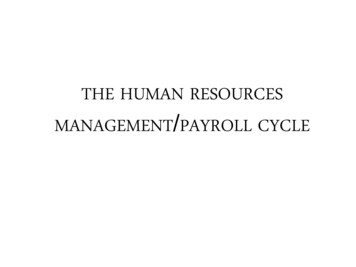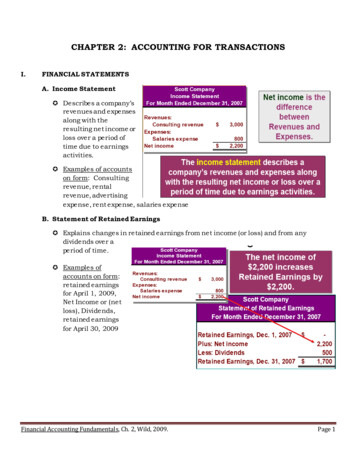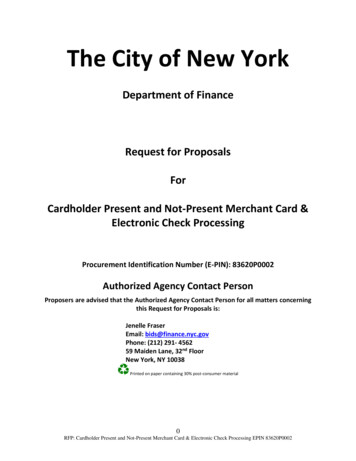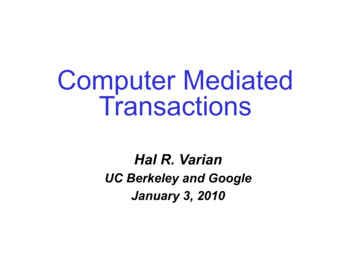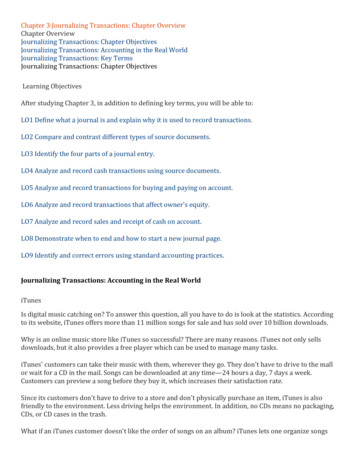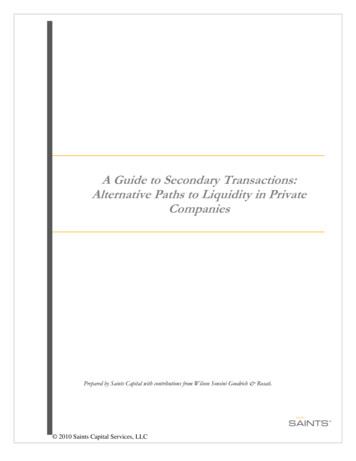
Transcription
A Guide to Secondary Transactions:Alternative Paths to Liquidity in PrivateCompaniesPrepared by Saints Capital with contributions from Wilson Sonsini Goodrich & Rosati. 2010 Saints Capital Services, LLC
A GUIDE TO SECONDARY TRANSACTIONS: ALTERNATIVE PATHS TO LIQUIDITY IN PRIVATE COMPANIESThis booklet was written by Ken Sawyer, Zack Scott and Balazs Veress of Saints Capital.Ken SawyerManaging Director(415) 395-2892ken@saintsvc.comZack ScottVice President(415) 321-6848zscott@saintsvc.comBalazs VeressAssociate(415) 321-6843bveress@saintsvc.comAcknowledgementsSaints Capital would like to thank Michael Coke and Elizabeth Hill at Wilson SonsiniGoodrich & Rosati, John Heath at The Brenner Group, and Paul Roney at Duff &Phelps for sharing their experience and insights with us during the preparation of AGuide to Secondary Transactions.This guide has been prepared for general informational purposes only and does not constituteadvertising, a solicitation or legal advice for any specific purpose by Saints Capital, Wilson SonsiniGoodrich & Rosati or any other party. This guide is not intended to create, and does not constitute theformation of, an attorney-client relationship or any other special relationship or privilege.Circular 230 Compliance. To ensure compliance with requirements imposed by the Internal RevenueService, we inform you that any U.S. federal tax information contained in this communication (includingany attachments) is not intended or written to be used, and cannot be used, for the purpose of (i)avoiding penalties under the Internal Revenue Code or (ii) promoting, marketing or recommending toanother party any transaction or matter addressed herein.1 2010 Saints Capital Services, LLC
A GUIDE TO SECONDARY TRANSACTIONS: ALTERNATIVE PATHS TO LIQUIDITY IN PRIVATE COMPANIESTable of ContentsOverview. 3When should someone consider a secondary transaction? . 5Founders and employees . 5Venture capital investors . 6Leveraged buyout investors . 7Company. 8Types of secondary buyers in the market . 10What to look for in a secondary partner . 12Process alternatives for a secondary transaction. 15The pricing of a secondary transaction . 17Possible transaction structures . 20Important considerations for the company and its board of directors. 23Legal considerations . 23Considerations for the board of directors . 27Case studies . 33 2010 Saints Capital Services, LLC2
A GUIDE TO SECONDARY TRANSACTIONS: ALTERNATIVE PATHS TO LIQUIDITY IN PRIVATE COMPANIESOverviewThe sale of private company shares on the secondary market is becoming increasingly prevalentas the timeline to reach a liquidity event has lengthened over the last decade. In order toproactively manage secondary transactions, the boards, management teams, and investors ofthese companies need to be aware of the relevant issues, challenges and considerations. Unlikepublic markets, where information disclosure rules are well established, rights and privileges ofexisting investors are limited and securities laws are well defined, the world of secondary sharesales in private companies is much less understood. While companies and investors are familiarwith security transactions involving a primary issuance of shares and are experienced with thosedynamics, secondary sales frequently involve a host of different issues. Secondary transactionsare often complex in structure, can have securities law implications for companies andparticipants in the transaction, and regularly involve specific arrangements between buyer andseller.For secondary transaction participants, relevant considerations include: a transaction’s implications on the motivations of employees and investors enforcement or waiver of the rights and privileges of the company and shareholders(particularly Rights of First Refusal, also referred to as a ROFR) implications of the transaction on a company’s 409A valuation selection of the appropriate buyer and potential new shareholder of the company processes allowed by the seller and the company legal issues for all parties involved information disclosure to a potential secondary buyer.What is a secondary sale of shares?A secondary sale (also referred to as a direct secondary sale) refers to the buying and selling ofan investor’s ownership in a privately held, frequently venture-backed or private equity-backed,company. The direct secondary market creates an option for management and investors,especially minority investors, to sell their stock when the entire company is not being sold.Investment stakes can be sold in a single company or across an entire portfolio of companies.While a robust secondary market for private equity-backed companies has existed for decades,historically, venture capital was too small a segment within the alternative assets class to supporta vibrant secondary market. However, over the past decade, there has been significant growth inthe amount of money allocated to venture capital investments (from 7.4B in 1995 to 28B in2008; source: NVCA). This growth in the venture industry has resulted in a striking disparitybetween venture capital investments and venture-backed company exits: venture capitalistsinvested in 31,676 deals between 2001 and 2009, but only 3,164, or 10%, of venture backedcompanies have had exits in that time period (source: NVCA).3 2010 Saints Capital Services, LLC
A GUIDE TO SECONDARY TRANSACTIONS: ALTERNATIVE PATHS TO LIQUIDITY IN PRIVATE COMPANIESFigure 1: U.S. VC Investments and Liquidity Events Number of venture 42,89331,676M&A exitsIPO exitsTotal Liquidity 75.2%244122568.8%2,7614033,164as % of total venture investments10.0%Source: NVCAAs a result of this disparity, the direct secondary market has emerged as an alternative liquidityvehicle for investors and founders/employees of venture-backed companies, and it has becomean important instrument for investors, companies and employees to address a variety of issuesthat they face.While this booklet is specifically targeted towards venture capital-backed companies, many ofthe issues and dynamics discussed also apply to other private equity investment, such as buyoutsand companies without existing professional investors. 2010 Saints Capital Services, LLC4
A GUIDE TO SECONDARY TRANSACTIONS: ALTERNATIVE PATHS TO LIQUIDITY IN PRIVATE COMPANIESWhen should someone consider a secondary transaction?Founders and employeesIt should come as no surprise to a founder or employee of a venture-backed company thatother shareholders and stakeholders in the company would have concerns regarding the sale ofstock by an insider. In public markets, insider buying and selling is closely regulated, tracked andgenerally seen as an indication of insider concern regarding the company’s prospects. It is nodifferent in a private company – and sometimes worse. Since the shares in privately heldcompanies are not actively traded in an open market, the ability for some people to achieve aliquidity event while others (i.e. venture investors) may not be able to do so, can cause someconsternation. Furthermore, since management and employees are crucial to the ongoinggrowth of a company and in achieving a liquidity event, many companies and investors areconcerned that allowing employees to sell their shares before an exit event will diminish theirmotivation. That being said, there are several situations when it is reasonable for employees,management and founders to search for some liquidity through a secondary transaction. Changes in personal financial or family situation – To the extent that an employee ishaving a child, has to move to meet the requirements of a growing family, or has financialneeds to pay for unexpected health care expenses, parental obligations or tuition, it isentirely reasonable to search for some liquidity from their ownership in a privately heldcompany. Differences of opinion amongst the founders, management and investors on whento sell the company – The decision to sell a company early versus taking more capital andbuilding the company for long-term success often highlights the risk/return differencesbetween investors and management teams. Allowing some liquidity to founders or earlyemployees can reinvigorate their desire to build the company and aim for a larger exit byrelieving some of their financial concerns and providing a capital cushion for their family. Employee departures or changing roles inside a company – When a founder has beenreplaced as CEO or an executive’s role inside the company has been changed, it is expectedthat, concurrent with that event, an employee wishes to sell some or all of their stock. Inthese situations, it is prudent, as part of any termination arrangement, to provide theemployee the ability to sell a portion or the entirety of their shares in the company and forthe company to cooperate with one or two sophisticated institutional buyers in that process,including waiving any transfer restrictions on the shares (assuming the employee or founderis leaving on good terms). Diversification – A founder or employee whose net worth is either entirely or significantlyheld in a single private company and who has worked at the company for several years (i.e.,at least four years) has a strong rationale to sell a minority portion of their stock in thecompany. As long as a meaningful amount of stock is still held by that employee or foundersuch that their interest are still aligned with the company’s goals, providing some liquidity toa long-time employee is entirely appropriate. Tax planning, estate planning or other financial planning needs – Many earlyemployees who own a substantial number of options may want to exercise those options5 2010 Saints Capital Services, LLC
A GUIDE TO SECONDARY TRANSACTIONS: ALTERNATIVE PATHS TO LIQUIDITY IN PRIVATE COMPANIESfor tax planning purposes. It is a very sensible request for an employee to ask permission tosell some of their options through a secondary transaction in order to get capital to exercisetheir remaining options. Similarly, a secondary transaction can help an employee manage thesale of their stock to optimize capital gains tax, AMT laws, or aid in estate planning. Expiring stock options or other stock awards – Due to the extended liquidity timelinesfor venture-backed companies, employees frequently find themselves holding stock optionsor other stock awards that are close to their expiration date. In these situations a companymay choose to allow an employee to sell a portion of options on the secondary market toprovide capital so that they can exercise their remaining holdings.Venture capital investorsJust as there are good rationales for founders, employees and management teams to seekliquidity for their stock, there are several compelling reasons for a venture fund to consider asecondary transaction. In general, enabling more capital to be returned to limited partners (LPs)sooner is a good thing for the venture industry as a whole. In particular, it is logical for angelinvestors and early stage VCs to consider liquidity for some of their older portfolios as thosecompanies mature. Over the past decade, the time to liquidity for venture backed companieshas increased dramatically from on average three years in 2000 to over nine years in 2010. Sincemost venture funds have ten year terms, it is expected that direct secondary transactions willbecome an increasingly common means of achieving liquidity. Some examples of why a ventureinvestor might consider a secondary transaction include: Return cash to limited partners – While many venture capitalists view themselves ascompany builders and take seriously the obligations that they have made to theentrepreneurs and companies in which they invested, venture capital firms have a primaryresponsibility to their limited partners. In today’s challenging economic environment manyfirms find themselves having not returned capital to their LPs in the seventh or eighth yearof a fund. When a firm finds itself in that situation, selling some or all of its holdings to asecondary investor is a sensible way to provide liquidity to their LPs and to ensurecontinued support for the companies they help start and fund. The firm’s expertise is investing in early-stage companies and its value-add isdecreasing over time – Venture capitalists generally acknowledge that some CEOs arebetter suited for start-ups and other CEOs are more appropriate for mature companies;however, they struggle to accept that some investors are better suited for early stageinvestments, but inexperienced in managing later stage private companies. While someinvestors can effectively manage a company over its different stages of development, manyothers would be better off refocusing their efforts on companies where their skills canprovide the greatest value. A secondary transaction can be an effective means for generalpartners to best match their expertise with the appropriate companies in their portfolio. The fund is over eight years old – A direct secondary transaction can help facilitate theorderly wind down of a fund that has come to the end of its life. It allows the generalpartners to provide cash returns to their limited partners, who would otherwise be leftholding illiquid assets, and avoids the need for fund extensions or annex funds whichfrequently come with unattractive terms for the general partners and earlier LPs. 2010 Saints Capital Services, LLC6
A GUIDE TO SECONDARY TRANSACTIONS: ALTERNATIVE PATHS TO LIQUIDITY IN PRIVATE COMPANIES Refocus the time and energy of the general partners – A direct secondary transactioncan free up general partners to devote their time and energy to more recent funds and focuson new investments. A portfolio company needs more money and the fund has no more reserves – Intoday’s environment, venture capital firms frequently find themselves unable to providenecessary follow-on financing to all of their portfolio companies. Particularly in “pay-toplay” situations, a sale to a new investor, with reserves and a willingness to invest in afollow-on round, may maximize the value of the investment for both parties and helps thecompany raise sufficient capital to accomplish its growth objectives. The partner who made the investment has left and the fund’s focus has moved toother industries or sectors – The venture capital landscape is littered with strandedinvestments due to changes in fund strategy, industry focus, or partnership dissolutions. Asecondary sale of “stranded” investments can often provide attractive returns for thosepositions that would otherwise wither away unattended. The fund has a different view than the board or management about the direction ofthe company – In late-stage companies, when investor syndicates can often be quite large,not everyone will always agree on the future course of the company. In many cases, findinga secondary investor more aligned with the majority view on the direction of the companycan be an effective means to resolve those differences while allowing for a graceful exit ofan investor that played an important role in the company’s early development.Leveraged buyout investorsWhile this booklet primarily focuses on topics surrounding secondary transactions in venturecapital backed companies, many of the same issues apply to buyout investors. In an economicenvironment, like today’s, where public and strategic exits are more challenging, and investorsyndicates have grown quite large, there are several good rationales to have a secondary investoracquire a minority interest in a business. Some examples of why a leveraged-buyout investormight consider a secondary transaction include: A co-investor wants liquidity – In the early days of leveraged buyouts, deals ofteninvolved just one investor who, along with management, owned all of the equity in acompany. In the recent past, however, the number of “club” deals has increasedconsiderably. In conjunction with this rise of syndicated deals, the number of co-investors(often limited partners of a fund) in any deal has grown as well. Quite often, investorsdevelop different views about exit timing or company strategy. In addition, the ownliquidity needs of co-investors frequently diverge from those of the controllingshareholders. Allowing an exit to a secondary investor in those situations can be an effectiveway to address these differences of opinion. An equity injection is needed – In today’s challenging economic environment, manyleveraged companies find themselves close to or in violation of their debt covenants and inneed of an equity cure to help address their credit burden. Frequently, in thesecircumstances, a co-investor’s desire or ability to provide additional equity alongside a7 2010 Saints Capital Services, LLC
A GUIDE TO SECONDARY TRANSACTIONS: ALTERNATIVE PATHS TO LIQUIDITY IN PRIVATE COMPANIESsponsor is also challenged. A secondary sale of the co-investment piece to a secondarybuyer, who is willing to provide additional follow-on financing, can both protect theposition from being wiped out and reduce the funding burden of the sponsor. . An investor wants to monetize a portion of its stake without selling the entirecompany – While private equity firms commonly sell their portfolio companies to otherprivate equity investors, there are often circumstances where an investor only wants toliquidate a portion of their position. Secondary investors can provide an alternative sourceof liquidity in these situations. For example, a private equity fund can sell 20% of itsownership stake in one or more companies in their portfolio while maintaining itsremaining ownership. A secondary sale not only allows a private equity firm to return capitalto its limited partners, but it can often provide a markup on the investment and enable it toreallocate capital to other companies within the portfolio.After a management change, departing executives seek partial liquidity – Privateequity backed companies regularly change their executive teams – due to performanceissues, personal reasons or an executives decision to take another job. In certain situations,it is reasonable to allow a departing executive to sell their shares to a secondary firm. Whilethe sponsor firm may often want to purchase the shares themselves, in some circumstances,such as if the departure is less than friendly or the sponsor fund is already fully invested,allowing a secondary fund to price and purchase the shares for sale makes sense.A private equity firm has outgrown the investment size of their earlier funds – Inrecent years, several of the most successful private equity firms have grown substantially insize, and many of these firms have outgrown the size of their earlier equity investments.These older investments, often, still take as much time and attention as the larger deals thefirm is currently focused on. In these cases, it makes sense for the fund to sell their smaller,older investments to a secondary firm and allow the investment professionals to focus moretime on their larger investments.CompanyJust as employees and investors often have good reasons to consider a secondary transaction, sotoo do companies. As a company matures, its investor base ages and the company’s need forcapital and board expertise change. A secondary transaction can help resolve many issues thatcompanies face. Retain and motivate employees – Recently, there have been several instances ofcompanies that essentially prevented, or strongly discouraged, existing employees fromselling any of their shares in a secondary transaction. As a result, in many of thosecompanies, some employees quit in order to sell their shares. The last thing a companywants to do is create an incentive for its best employees to leave so that they can sell theirstock. By allowing employees to sell small amounts of vested shares or options in asecondary transaction, a company can empower their employees with the knowledge thatthey can receive additional compensation beyond their salary and bonus to help relieve thefinancial pressures they might face. Permitting employees to sell a portion of their shares onthe secondary market can become a huge incentive to stay at a more mature firm versusgoing to a start up. 2010 Saints Capital Services, LLC8
A GUIDE TO SECONDARY TRANSACTIONS: ALTERNATIVE PATHS TO LIQUIDITY IN PRIVATE COMPANIES Remove or swap an investor who is not supportive of the current strategy ormanagement – Dysfunctional board dynamics can inhibit value creation. By replacing anunhappy investor, a secondary transaction can help realign the interests of the investor baseand enable the company to execute on it business objectives. Clean up the capitalization table – In today’s venture landscape, there are manymisaligned capitalization tables with a long list of tired, early investors. A secondarytransaction can help clean up a disorderly capitalization table and provide a refreshedinvestor base for the company. In addition, a secondary sale can help a company manage itsnumber of shareholders. By acquiring several smaller shareholder positions, a secondaryinvestor can help a company avoid public reporting requirements by keeping theirshareholder base bellow the maximum number allowed for a private company. Realign investor interests – In today’s environment of prolonged exit timelines,companies can frequently find themselves in situations where their investors havemisaligned interests and investment goals. By providing liquidity to earlier investors, adirect secondary transaction can help a company realign its investor base with an agreedupon exit timing and path. Assist in follow-on financings – Today, many companies find themselves in theunfortunate situation of having investors who, although supportive of the company, areunable to provide the necessary follow-on financing needed to sustain growth anddevelopment. A secondary transaction can not only provide some liquidity to thoseinvestors, but it can also provide the company with the necessary funding to reach its nextimportant milestones.9 2010 Saints Capital Services, LLC
A GUIDE TO SECONDARY TRANSACTIONS: ALTERNATIVE PATHS TO LIQUIDITY IN PRIVATE COMPANIESTypes of secondary buyers in the marketThere are six major types of active participants in the direct secondary market: Existing investors or the companyExisting investors in a company or the company itself can repurchase shares fromemployees or other investors. For companies with substantial excess cash (ideally due tocash generation from operations), it may make sense for the company itself to acquireshares from employees or investors, similarly to the way public companies conduct sharebuybacks. However, if the company is burning cash or saving cash for acquisitions, thisoption may not be appropriate. Sometimes, existing investors may wish to increase theirstake in a company. If the company is unlikely to need further capital (therefore reserves atthe fund level are not needed) and the inside investor is prepared to pay a reasonable price,they can often be a good buyer of shares. However, since the mandate of the primaryinvestor fund is to provide capital for growth and other corporate purposes, the potentialfor significant secondary stake liquidation is often limited. Further, an additional investmentin secondary shares may limit the investor’s appetite in the future for growth capital oracquisition funding. A primary investorMany primary venture capital firms have struggled to provide attractive returns andmeaningful liquidity to their investors and as a result have considered or began to exploresecondary transactions. In addition, some investors may have tried to participate in aprimary round with a company but lost out to another firm, and as an alternative route, theymay consider investing through a secondary opportunity. However, since many primaryfirms do not want to buy common or junior preferred stock, the number of primary firmsactively pursuing secondary deals is limited. Fund-less sponsorsFund-less sponsors are participants in the secondary market who aim to identifyshareholders seeking liquidity and negotiate a transaction with them. However, instead offinancing the deals from an existing fund, the financial backing is arranged on a deal-by-dealbasis. These agents or firms usually get compensated with a fee for their intermediaryservices and/or receive profit sharing after the eventual sale of the stake that was acquiredwith their help. Sometimes funds will be formed by boutique banks that raise money from asmall group of wealthy investors with a mandate to buy shares in one company. It isfrequently the case that fund-less sponsors will provide an offer or letter-of-intent and usethat agreement to raise money from a third party to consummate a transaction; however,the transactions often fail to close if these groups cannot raise the promised capital. Secondary exchangesThanks in part to some highly publicized transactions in 2010 (e.g., Facebook, Zynga,LinkedIn, and Twitter), secondary exchanges have become well known as an avenue whereprivate stocks can change hands. Examples of these exchanges are SecondMarket,NYPEXX, and Sharespost. However, these exchanges are limited in their ability to provideinformation about the underlying companies and frequently charge additional feesassociated with the transaction. In addition, secondary exchanges tend to focus only on afew highly publicized, “popular” companies. Transactions in these companies are executed 2010 Saints Capital Services, LLC10
A GUIDE TO SECONDARY TRANSACTIONS: ALTERNATIVE PATHS TO LIQUIDITY IN PRIVATE COMPANIESmore on public perception rather than investing fundamentals, leaving a significant numberof valuable, privately held companies without access to liquidity on the secondary market.Secondary exchanges are a great platform for smaller transactions when, for example, 100,000 worth of shares need to be sold and the diligence requirements of the buyer areminimal. In situations where larger stakes need to find a buyer or the company is lookingfor someone who can also participate in follow-on financings, these platforms are not theideal place to unite buyers and sellers as most buyers on these exchanges are wealthyindividuals and small institutions. MegabuyersA small group of players across the globe have been making the headlines with large director secondary investments in promising internet companies. These include Digital SkyTechnologies from Russia who has spent 800 million buying Facebook shares fromemployees; Elevation Partners, a US private equity firm; and Tiger Global Management, aUS-based hedge fund. Similarly to the secondary exchanges, these funds tend to focus onlyon a few relatively mature companies, and are not interested in purchasing shares in the vastmajority of venture-backed companies. For a select group of companies, typically those thatcan transact at valuations well in excess of 1 billion, these buyers can have attractiveattributes – the ability to write large checks, to provide some primary capital, and often topay premium prices. Secondary fundsBroadly speaking, there are two types of secondary funds: direct secondary funds andindirect secondary funds. Direct secondary funds are investment firms with dedicatedcapital whose sole mandate is to provide liquidity to sellers of private company shares.These firms engage not only with individual shareholders of a given company, but they willalso acquire complete portfolios from venture firms, corporations or family offices. Directsecondary funds assume ownership of the companies themselves and often times becomeactive managers of these assets (in some cases in partnership with the existing fund GPs).Indirect secondary funds, on the other hand, buy limited partnership (LP) interests in otherinvestment funds and basically replace current investors in a fund. They hold these stakesuntil the private equity fund sells their portfolio companies and distributes the capital.Indirect secondary investors typically do not have any direct involvement in themanagement or oversight of the underlying companies. A small number of indirectsecondary funds will do select direct secondary transactions, but it is not a core part of theirbusiness.11 2010 Saints Capital Services, LLC
A GUIDE TO SECONDARY TRANSACTIONS: ALTERNATIVE PATHS TO LIQUIDITY IN PRIVATE COMPANIESWhat to look for in a seconda
A secondary sale (also referred to as a direct secondary sale) refers to the buying and selling of an investor's ownership in a privately held, frequently venture-backed or private equity-backed, company. The direct secondary market creates an option for management and investors,



